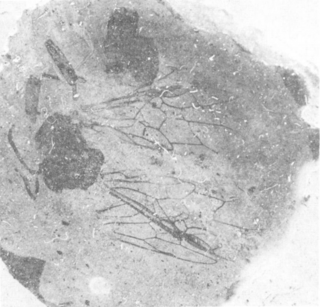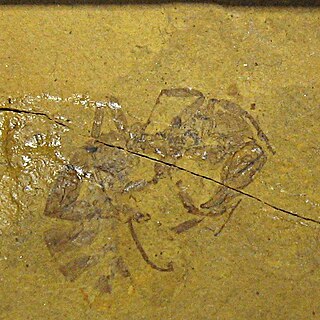
Nursery web spiders (Pisauridae) is a family of araneomorph spiders first described by Eugène Simon in 1890. They resemble wolf spiders (Lycosidae) except for several key differences. Wolf spiders have two very prominent eyes in addition to the other six, while a nursery web spider's eyes are all about the same size. Additionally, female nursery web spiders carry their egg sacs with their jaws and pedipalps instead of attaching them to their spinnerets as wolf spiders do. When the eggs are about to hatch, a female spider builds a nursery "tent", places her egg sac inside, and stands guard outside, hence the family's common name. Like the wolf spiders, however, the nursery web spiders are roaming hunters that don't use webs for catching prey.

Archaeidae, also known as assassin spiders and pelican spiders, is a spider family with about ninety described species in five genera. It contains small spiders, ranging from 2 to 8 millimetres long, that prey exclusively on other spiders. They are unusual in that they have "necks", ranging from long and slender to short and fat. The name "pelican spider" refers to these elongated jaws and necks used to catch their prey. Living species of Archaeidae occur in South Africa, Madagascar and Australia, with the sister family Mecysmaucheniidae occurring in southern South America and New Zealand.
Ulteramus is an extinct genus of parasitic wasp in the sawfly family Pamphiliidae. The genus is solely known from an Eocene fossil found in North America. At the time of its description the new genus was composed of a single species, Ulteramus republicensis.

Megarachne is a genus of eurypterid, an extinct group of aquatic arthropods. Fossils of Megarachne have been discovered in deposits of Late Carboniferous age, from the Gzhelian stage, in San Luis, Argentina. The fossils of the single and type species M. servinei have been recovered from deposits that had once been a freshwater environment. The generic name, composed of the Ancient Greek μέγας (megas) meaning "great" and Ancient Greek ἀράχνη (arachne) meaning "spider", translates to "great spider", because the fossil was misidentified as a large prehistoric spider.
Eoplectreurys is an extinct monotypic genus of spider from the family Plectreuridae, with a sole species, Eoplectreurys gertschi. The fossils of Eoplectreurys were recovered from the ~164 Ma old Middle Jurassic Daohugou formation tuffs in Inner Mongolia, China.

Archiinocellia is an extinct genus of snakefly in the family Raphidiidae known from Eocene fossils found in western North America. The genus contains two species, the older Archiinocellia oligoneura and the younger Archiinocellia protomaculata. The type species is of Ypresian age and from the Horsefly Beds of British Columbia, while the younger species from the Lutetian Green River Formation in Colorado. Archiinocellia protomaculata was first described as Agulla protomaculata, and later moved to Archiinocellia.

Dinokanaga is a small genus of scorpionfly belonging to the extinct family Dinopanorpidae. The six species D. andersoni, D. dowsonae, D. hillsi, D. sternbergi, D. webbi, and D. wilsoni have all been recovered from Eocene fossil sites in British Columbia, Canada, and Washington state, United States.

Pseudosiobla campbelli is an extinct species of sawfly in the family Tenthredinidae that is known from early Eocene Ypresian stage lake deposits near the unincorporated community of Horsefly, British Columbia.
Garcorops jadis is a possibly extinct species of Wall crab spider, family Selenopidae, and at present, it is one of four known species in the genus Garcorops. The species is solely known from copal found on the beach near Sambava, on the northeast coast of Madagascar.

Mongolarachne is an extinct genus of spiders placed in the monogeneric family Mongolarachnidae. The genus contains only one species, Mongolarachne jurassica, described in 2013, which is presently the largest fossilized spider on record. The type species was originally described as Nephila jurassica and placed in the living genus Nephila which contains the golden silk orb-weavers.

Eriocampa tulameenensis is an extinct species of sawfly in the family Tenthredinidae that is known from early to early middle Eocene lake deposits near the small community of Princeton, British Columbia in the Similkameen region.
Konrad Thaler was an Austrian arachnologist.
Uintascorpio is an extinct genus of scorpion in the family Buthidae and containing the single species Uintascorpio halandrasorum. The species is known only from the Middle Eocene Parachute Member, part of the Green River Formation, in the Piceance Creek Basin, Garfield County, northwestern Colorado, USA.

Myrmeciites is an extinct form genus of bulldog ants in the subfamily Myrmeciinae of the family Formicidae, which contains three described species and two fossils not placed beyond the genus level. Described in 2006 from Ypresian stage deposits, all three of the described species and one unplaced fossil are from British Columbia, Canada, while the second unplaced fossil is from Washington State, USA. These ants were large, with the largest specimens collected reaching 3 centimetres (1.2 in). The behaviour of these ants would have been similar to extant Myrmeciinae ants, such as solitary foraging, nesting either in the soil or trees, and leaving no pheromone trail to food sources. Due to the poor preservation of these ants, their phylogenetic position among Myrmeciinae is unclear, and no type species has been designated. These ants are classified as incertae sedis in Myrmeciinae, but some writers have classified it as incertae sedis within the insect order Hymenoptera. This reclassification, however, has not been accepted; instead, Myrmeciites remains in Myrmeciinae.

Seppo is an extinct genus of spiders, possibly of the superfamily Palpimanoidea, that lived about 180 million years ago, in the Early Jurassic of what is now Europe. The sole species Seppo koponeni is known from a single fossil from Grimmen, Germany. With the scorpion Liassoscorpionides, it is one of the two only known arachnids from the Lower Jurassic of Germany. Seppo is the first unequivocal Early Jurassic spider, and was recovered from the Green Series member of the Toarcian Ciechocinek Formation.

Lagonomegopidae is an extinct family of spiders known from the Cretaceous period. Members of the family are distinguished by a large pair of eyes, positioned on the anterolateral flanks of the carapace, with the rest of the eyes being small. They have generally been considered members of Palpimanoidea, but this has recently been questioned. Members of the family are known from the late Early Cretaceous (Albian) to near the end of the Late Cretaceous (Campanian) of Eurasia, North America and the Middle East, which was then attached to Africa as part of Gondwana. They are generally assumed to have been free living hunters as opposed to web builders.
The paleofauna of the Eocene Okanagan Highlands is comprised of Early Eocene arthropods, vertebrates, plus rare nematodes and molluscs found in geological formations of the northwestern North American Eocene Okanagan Highlands. The highlands lake bed series' as a whole are considered one of the great Canadian Lagerstätten. The paleofauna represents that of a late Ypresian upland temperate ecosystem immediately after the Paleocene-Eocene thermal maximum, and before the increased cooling of the middle and late Eocene to Oligocene. The fossiliferous deposits of the region were noted as early as 1873, with small amounts of systematic work happening in the 1880-90s on British Columbian sites, and 1920-30s for Washington sites. Focus and more detailed descriptive work on the Okanagan Highlands site started in the last 1970's. Most of the highlands sites are preserved as compression-impression fossils in "shales", but also includes a rare permineralized biota and an amber biota.
Eoseira is an extinct genus of diatoms belonging to the family Aulacoseiraceae and containing the single species Eoseira wilsonii. The species is dated to the Early Eocenes Ypresian stage and have only been found at the type locality in east central British Columbia.

Promastax is a genus of "monkey grasshoppers" belonging to the extinct monotypic family Promastacidae and containing the single species Promastax archaicus. The species is dated to the Early Eocenes Ypresian stage and has only been found at the type locality in east central British Columbia.

Weygoldtina is an extinct genus of tailless whip scorpion known from Carboniferous period, and the only known member of the family Weygoldtinidae. It is known from two species described from North America and England and originally described in the genus Graeophonus, which is now considered a nomen dubium.












